There are some seriously strong snake species out there. However, most aren’t actually found in North America and instead tend to live in places like the Asian continent. That being said, the United States does have some pretty hefty snakes that can cause serious damage when hunting for food or protecting themselves.
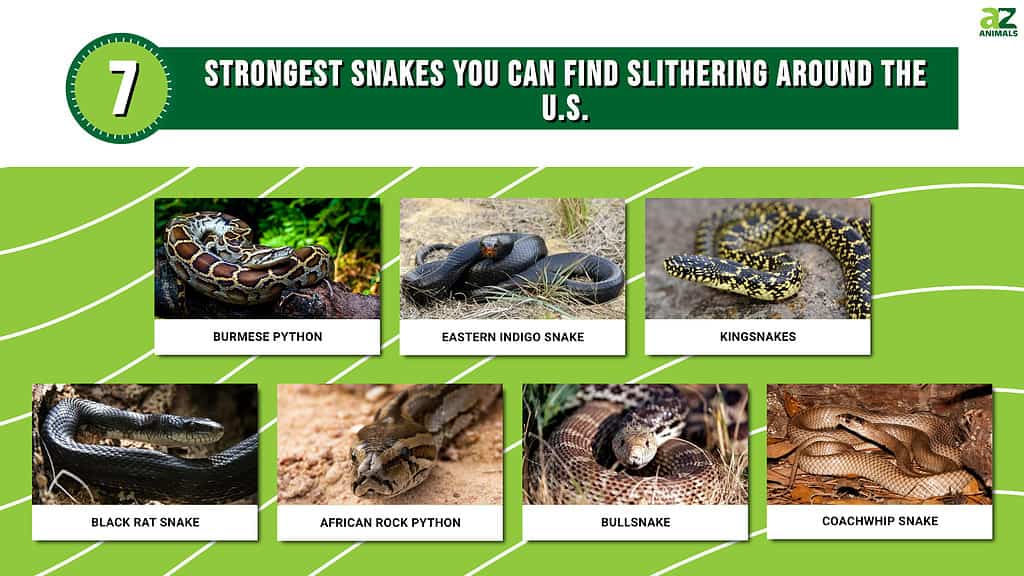
It’s worth noting that we are talking about strength in terms of muscle strength, not venomous strength. So, while many of this list’s snakes are strong enough to cause serious damage, they may not be as deadly as snakes with strong venom. It’s also worth noting that this list isn’t ranked by strength, as individual specimens can be stronger than others among their species. With that in mind, let’s look at some of the strongest snake species in the United States.
1. Burmese Python
Classification: Python bivittatus
Southeast Asia is home to the huge constrictor snake known as the Burmese python. In certain areas of the United States, notably Florida, it has spread as an invasive species. The size, power, and flexibility of these pythons are truly astounding.
One of the world’s biggest snake species, the Burmese python can grow to exceed 20 feet in length and weigh more than 200 pounds. They are able to easily overwhelm and enclose their victim because of their enormous size and great strength.
Burmese pythons are opportunistic predators with a varied diet. Rats, rabbits, and birds are among the tiny to medium-sized animals on their menu. However, they have been observed eating bigger species in their invading area, including deer and alligators, proving their capacity to take on strong opponents.
Burmese pythons have developed colonies throughout the United States, notably in Florida’s Everglades National Park. The pythons can survive in this subtropical area’s ideal environment, which includes a variety of marshes, wetlands, and dense vegetation. They can live in a variety of different places and are quite adaptive.
Concerns about Burmese pythons’ effects on local fauna have been raised by their presence in Florida. They have been noted as endangering a number of threatened species and upsetting the sensitive ecosystem’s equilibrium. With the help of public awareness campaigns and eradication initiatives, efforts have been undertaken to manage their numbers.

The Burmese python (pictured) is an invasive species in states like Florida.
©dwi putra stock/Shutterstock.com
2. Eastern Indigo Snake
Classification: Drymarchon couperi
The southern region of the United States is home to the fascinating non-venomous Eastern indigo snake. It boasts the distinction of being the longest native snake species in the nation and is renowned for both its size and power. It can reach a maximum length of eight feet and has a strong, muscular body.
The Eastern indigo snake is renowned for having great constriction power. It captures and overwhelms its prey, which includes a range of tiny animals, birds, reptiles, and even poisonous snakes, using its powerful coils. Due to its power, it is able to catch and eat food that would be difficult for other snake species to handle.
The longleaf pine forests, pine flatwoods, and scrublands of the southeast coastal plain of the United States are the Eastern indigo snake’s primary habitats. States including Georgia, Florida, Alabama, and Mississippi contain it. The snake can find enough food and a suitable place to live in these settings.
The Eastern indigo snake is regarded as an endangered species as a result of habitat loss, degradation, and other causes. Its surviving populations and habitats are being protected via conservation initiatives. To help this amazing and ecologically significant snake species survive and recover, efforts are being made to manage the land, conduct captive breeding programs, and restore habitat.
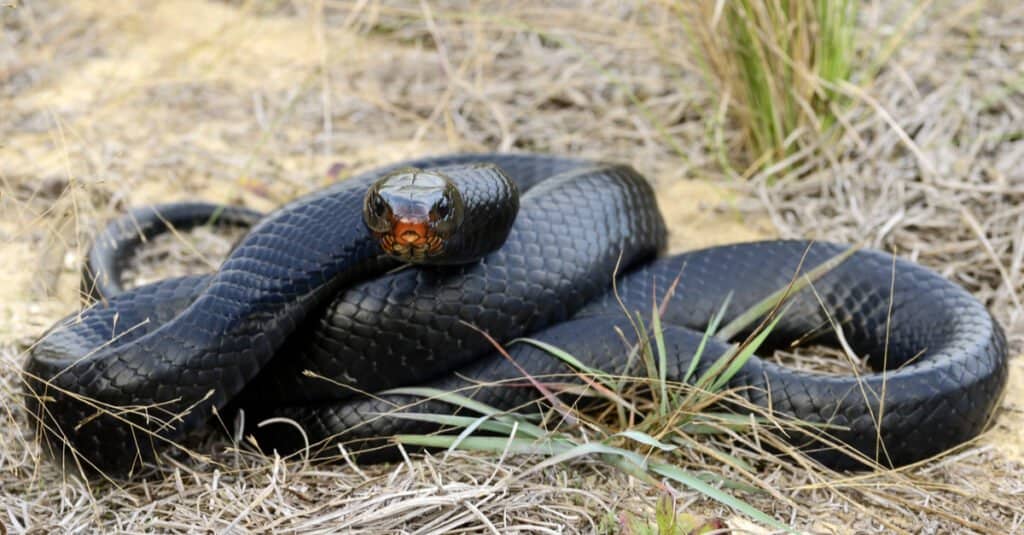
Eastern indigo snakes (pictured) have serious constriction power despite not being a very large snake.
©Patrick K. Campbell/Shutterstock.com
3. Kingsnakes
Classification: Lampropeltis genus
We can’t talk about the world’s strongest snakes without mentioning kingsnakes! The Lampropeltis genus of snakes includes a group of non-venomous snakes known as kingsnakes. They are renowned for their stamina, flexibility, and stunning color patterns. Depending on the species, different parts of the United States have different populations of kingsnakes.
Kingsnakes are strong because they have strong muscles and are constrictors, which allows them to crush and overwhelm their victim. Their power is noticeable, even if they may not grow to the same size as some of the bigger constrictor species. Rodents, birds, lizards, frogs, and even other snakes, even venomous varieties, may all be constrained and subdued by them.
Kingsnakes are flexible eaters and opportunistic hunters. The fact that they can eat poisonous snakes like rattlesnakes has given them the title of “kings” among snake species. They may survive in environments where other predators might be discouraged because they are resistant to the poison of the venomous snakes they eat.
Depending on the species, several kingsnakes can be found throughout the United States. For instance, the Eastern kingsnake has a larger range that includes the eastern and southeastern areas of the United States, but the California kingsnake is mostly found in California and parts of the surrounding states.
Because of their adaptability, kingsnakes may live and prosper in a range of settings, including woods, grasslands, deserts, and even regions populated with humans. They can access a variety of prey and environments since they are skilled climbers and burrowers.
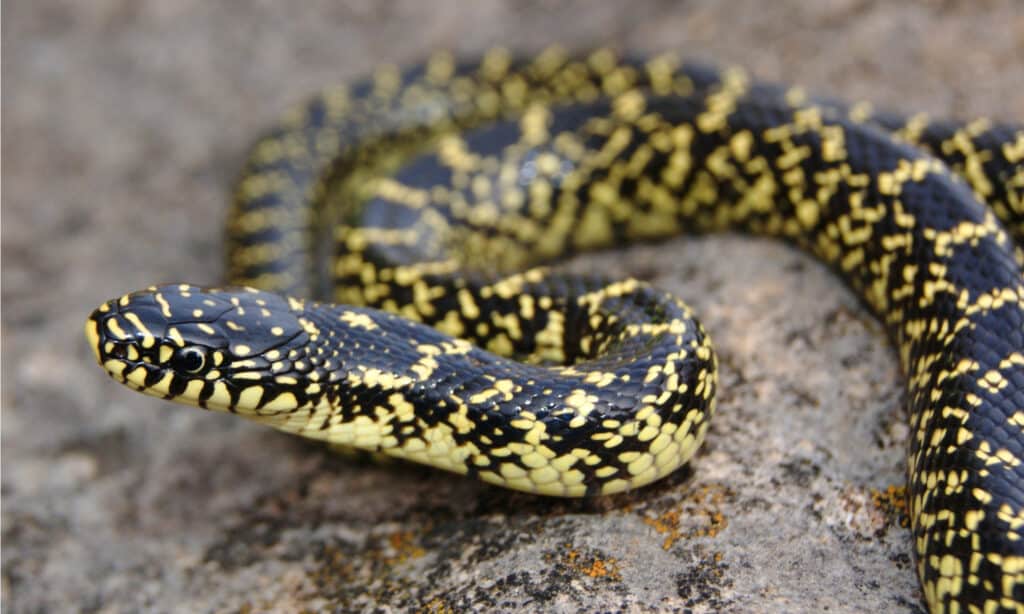
The speckled kingsnake (pictured) is one of the strongest of the kingsnakes.
©Matt Jeppson/Shutterstock.com
4. Black Rat Snake
Classification: Pantherophis obsoletus
The non-venomous black rat snake may be found throughout much of the eastern United States. They are renowned for their physical strength and involvement in managing rodent infestations.
Black rat snakes are strong, despite not being as huge as some constrictor species. They have strong bodies and are adept climbers. These creatures can efficiently overwhelm and restrain their victim thanks to their strength. They are skilled climbers of trees, able to weave between limbs and snag food including rodents, birds, eggs, and occasionally even small mammals.
The majority of black rat snakes’ habitats are woods, woodlands, fields, and agricultural areas. They favor locations with lots of foliage, cover from the sun, and access to prey populations. Their distribution extends from areas of Texas and Florida to the northern United States.
Black rat snakes are skilled predators of rats and other rodents, as their name indicates. They are advantageous to people and ecosystems because they are essential in managing rodent populations. They may also eat birds, eggs, amphibians, and tiny reptiles in addition to rodents.
These snakes are distinguished by their dark coloring, which can differ significantly from individual to individual and area to region. Some may have spots or patterns on their bodies, and they frequently have white or gray bellies.
Black rat snakes play a crucial role in maintaining the balance of prey populations and acting as pest predators in their respective environments. They are often calm and non-aggressive toward people.

Black rat snakes (pictured) are named after the fact that they control rat populations.
©Ryan M. Bolton/Shutterstock.com
5. African Rock Python
Classification: Python sebae
Sub-Saharan Africa is home to the huge and strong African rock python species. Although African rock pythons are not native to the United States, there have been instances of them being introduced or escaping into the wild in some places, most notably in the state of Florida.
African rock pythons are among the strongest and biggest snake species in the world. They may grow to lengths of more than 20 feet, and their strong muscles enable them to enclose and overwhelm their victim. It has been shown that they hunt and eat a wide range of creatures, including mammals, birds, and reptiles.
The majority of the African rock python’s native range is made up of grasslands, savannas, and semi-aquatic regions like marshes and swamps. They can live in aquatic bodies, such as lakes and rivers, and they are competent swimmers. However, it’s crucial to remember that they are regarded as invasive when they are introduced to and established in the United States since they may harm local fauna.
African rock pythons are ambush predators that wait for their prey to approach before attacking and strangling it. They eat birds and other reptiles in addition to mammals including antelope, monkeys, and rodents. They can eat prey that is larger than their own head because of their flexible jaw and expanded stomach.
Concerns about the possible effects of African rock pythons on local species and ecosystems have been raised by their arrival in Florida. They are apex predators and have the power to alter regional food webs. To lessen the detrimental impacts on the ecosystem, efforts are being made to monitor and control their numbers.
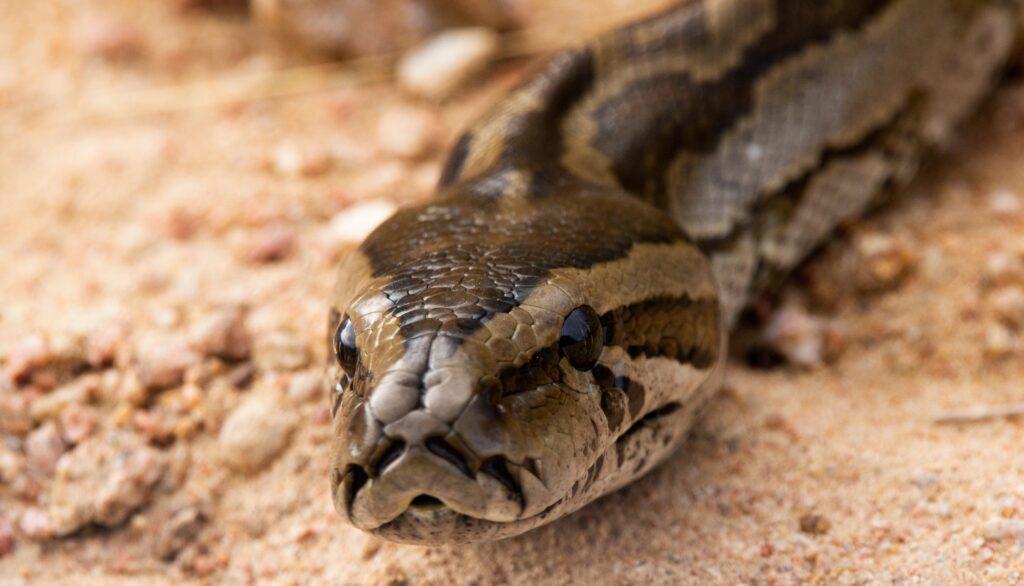
Rock pythons (pictured) are not native to the United States but have been introduced as an invasive species.
©Bruce Crossey/Shutterstock.com
6. Bullsnake
Classification: Pituophis catenifer
Constrictor snakes known as bullsnakes are non-venomous and can be found across the United States. They are renowned for their power, visual appearance, and ability to manage rodent infestations in many areas.
Bullsnakes are much stronger than some of the other constrictor species, despite their smaller size. They have strong bodies and are skilled climbers. They can overwhelm and encircle a variety of prey, including small animals, birds, eggs, and sporadically even other snakes, thanks to their strength.
Numerous subspecies of these snakes live in various parts of the United States, giving them a widespread range. Their range includes areas of the western United States, such as Arizona, New Mexico, and Colorado, as well as the Great Plains, which include states like Texas, Oklahoma, Kansas, and Nebraska.
Open grasslands, prairies, shrublands, and even agricultural regions are where you’ll find bullsnakes most often. They favor areas where rodents are plentiful because they eat a lot of them. They may also eat birds, eggs, lizards, and other small reptiles in addition to rodents. Bullsnakes are advantageous to human environments because they play a significant part in controlling rodent populations.
These snakes are renowned for their unusual look, with a background hue of tan or yellow and dark blotches or stripes running down their bodies. They have tough scales as well. Bullsnakes are mostly non-venomous and gentle, but when threatened, they may hiss or make a rattlesnake sound.

Bullsnakes (pictured) are large and a bit freaky, but they are not dangerous to humans and are beneficial to have around.
©iStock.com/92968526
7. Coachwhip Snake
Classification: Masticophis flagellum
Non-venomous coachwhip snakes can be found across the United States. With long, thin bodies and a tail that resembles a whip, they are renowned for their agility, speed, and unusual look.
Coachwhip snakes are very nimble and quick, even though they may not have the same raw strength as some of the bigger constrictor species. They depend less on brute strength and more on quickness and evasive techniques. Their primary prey, which includes small animals, birds, lizards, and other snakes, may then be captured and subdued thanks to this. Because they are adept hunters, they can capture their victims with fast attacks and strangulation.
Coachwhip snakes can be found all throughout the country in a variety of habitats and geographical areas. They may be found in rocky places, open meadows, deserts, and scrublands. They favor environments with lots of foliage cover so they can conceal themselves and move covertly.
Coachwhip snakes can be found in the central and eastern United States as well as the southern and southwestern United States, encompassing states like Texas, Arizona, New Mexico, and California.
How cool are these super-strong American snakes? While many of the snakes are not dangerous, some could become potentially dangerous if handled. Remember to always exercise caution when approaching any snake in the wild.
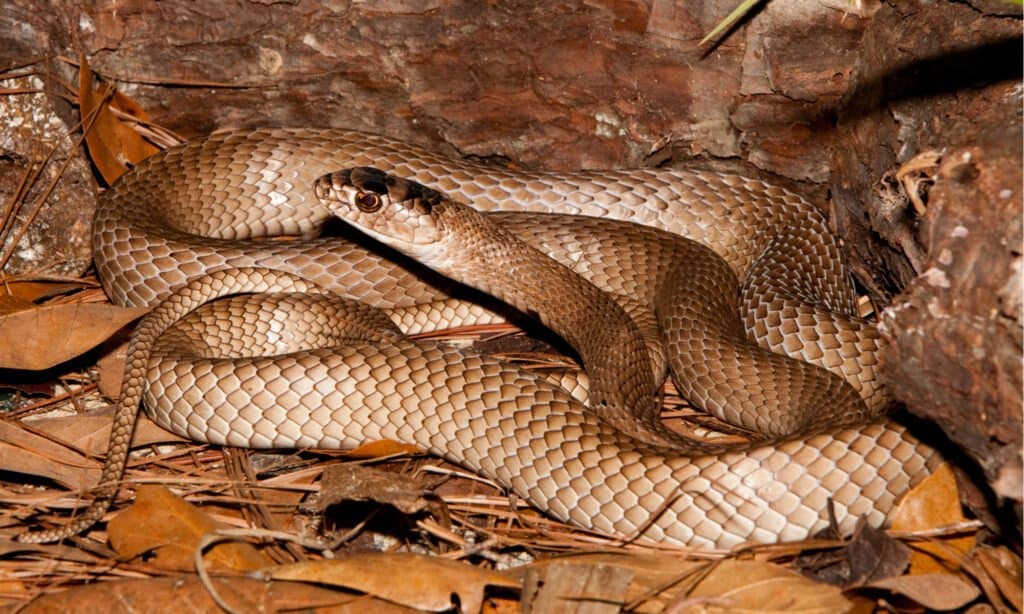
Coachwhip snakes (pictured) are very strong snakes that are also known for being speedy.
©Jay Ondreicka/Shutterstock.com
Summary of 7 Strongest Snakes You Can Find Slithering Around the U.S.
| Snake | Classification | |
|---|---|---|
| 1 | Burmese Python | Python bivittatus |
| 2 | Eastern Indigo Snake | Drymarchon couperi |
| 3 | Kingsnakes | Lampropeltis genus |
| 4 | Black Rat Snake | Pantherophis obsoletus |
| 5 | African Rock Python | Python sebae |
| 6 | Bullsnake | Pituophis catenifer |
| 7 | Coachwhip Snake | Masticophis flagellum |
The photo featured at the top of this post is © iStock.com/Lunatic_67
Discover the "Monster" Snake 5X Bigger than an Anaconda
Every day A-Z Animals sends out some of the most incredible facts in the world from our free newsletter. Want to discover the 10 most beautiful snakes in the world, a "snake island" where you're never more than 3 feet from danger, or a "monster" snake 5X larger than an anaconda? Then sign up right now and you'll start receiving our daily newsletter absolutely free.
Thank you for reading! Have some feedback for us? Contact the AZ Animals editorial team.






